Agung pratama
Seal ICO Review

What is Seal?
Its is a Brand and consumer focused anti counterfeiting systems that everyday people will want to use.
Seal will use secure NFC embedded chips synchronized with blockchain technology to allow product authenticity, adding additional value and information about the product, such as product history.
Verification of authenticity is instantaneous with a simple tap or scan with any smart device such as a phone.
Seal is a Dutch company and the NFC chips are manufactured by NXP semiconductors which is also based in the Netherlands.
How does it work
At the simplest level. You scan a product and it can be verified by secure blockchain.
Brands can charge a variable fee depending on the product and added services and functions the chip provides. This helps fight counterfeiting and the consumer gets to support the designers and brands they love.
On the secondary market, it will be easier to sell your product at a higher price because other people can validate the authenticity. You can also claim an individual product as yours. There will be a small fee for change of ownership and claiming.
So brands can still make a very small cut on the secondary sale of an item and the seller can likely get a better price. Seal also cuts a very small cut of this fee which benefits token holders as a small percent of tokens are burnt with every transaction.
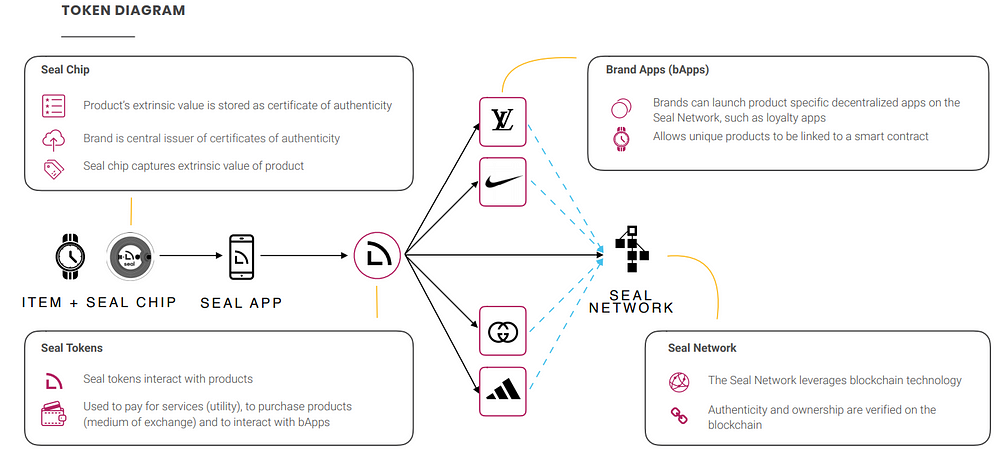
App front end and back end
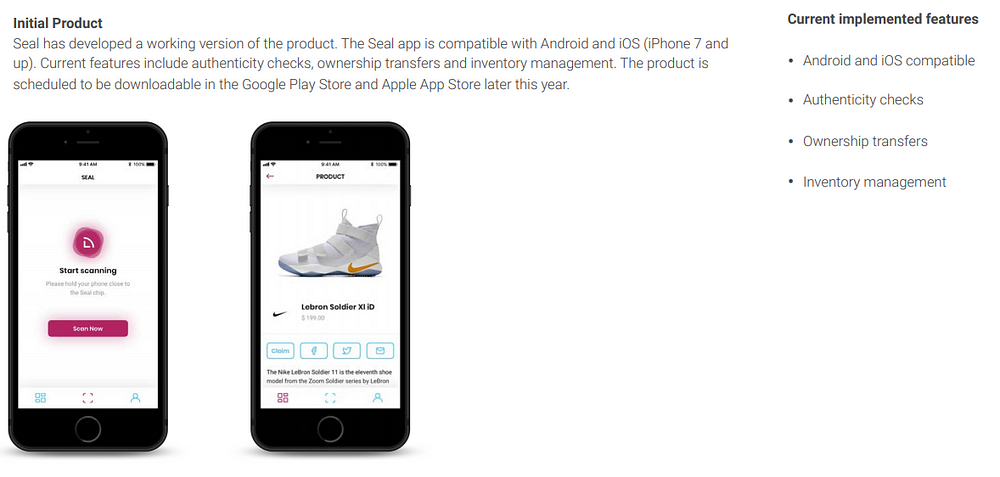
Brands can create their own front end app or use seals native user interface. The app has unlimited applications but the blockchain can only store limited data. Seal already have a working application that can be used for basic functions.
Luxury Brands
Seal plans to target luxury brands as a starting point. I think it is a decent starting point as people that buy luxury brands want a guarantee it is 100% the the real deal. I can see real value here for both consumers and luxury brands
Anti theft
Because the chips can be embedded into the product and would require damage to the item to remove, stolen goods would be easy to identify. If you wanted to buy a second hand TV you could easily tap your phone and see if it is listed as stolen or not by the owner.
Lost items
This is just me thinking of other uses here as I am always losing stuff. Say you lose something. Anyone could scan it and find out who the owner might be and there may even be a reward for returning it! As the claimer of the item you could choose to have things like contact email address visible or not.
Third party apps
Again just me thinking of possible uses. Because the blockchain information is public anyone could potentially create and app and use this information to create a new business. They could track all sorts of info that others do not want to. For example an app could be created purely for art or antiques which tracks all the auctions and price history etc etc. Seal does also plan to offer this but there is a chance for other parties to also start their own thing outside Seals scope.
Other uses
Imagine every TV or laptop having one of these chips installed. You can be sure you never buy stolen goods. If the market for stolen goods is reduced this may even reduce burglaries (I am dreaming I know!).
Collectors items and cards
Take baseball cards for example. There is so much history behind these and verifying a fake would be very difficult. If the thin sticker version of the seal chip was embedded between the cards layers the history of that card can be verified instantly without any kind research or specialist info required.
Food and drink
Chips and be embedded into the product in such a way it would be clear it has been tampered with or in such a way the chip will destroy itself when a consumable is opened. For example that expensive bottle of wine.
Medicines
Self explanatory really. This is a major problem in developing countries
The possibilities go on and on really.
The Team
The team has some very encouraging advisers and team members.
You can read more about the team on there website here. Seal Network team link
The two main team memebers are brothers Bart and Joris.
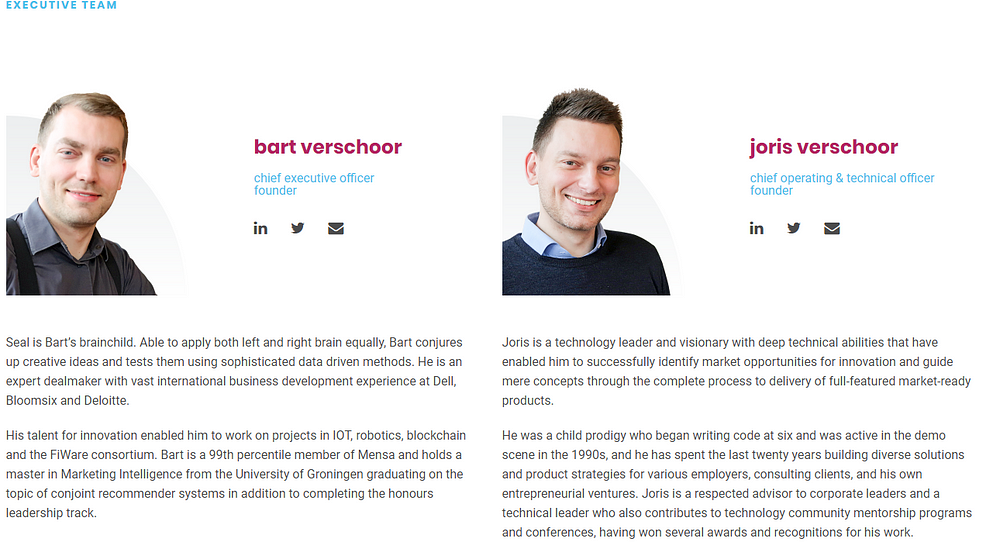
They have two advisers who work at or were involved with NXP semi conductors which shows how close their relationship is with the company they source their chips from.
I have asked many questions on their telegram and they have a stand out team member Michael De Blok who really goes out of his way to answer questions. If he doesn’t know the answer he gets back to you.
I have vetted the team to a high standard and I can find no issues or question marks. They have turned up at several blockchain conferences and many people I know have met them in person and talked to them and had good things to say.
The advisers are well known people and from decent brands. DYOR to ensure you cant find something I did not.
What problem are they solving?
We all know the problem of counterfeiting, it is pretty obvious. One out of five products made in China is a fake.
This is a big problem world wide more so in less developed countries. The most concerning being consumables, fake food, medicine and even alcohol.
Expensive spirits which are very popular as a gift in China can command price tags of around $160 USD. I use this as an example as I recently traveled to China was was given such a gift from a friend of mine who is a distributor.
Around 10% of these products are fake. Companies already employ several tricks to beat the fakes. Such as total redesign of the packaging often which is very expensive. QR codes and even other similar inferior RFID technologies that are already hacked and by-passable.
The cost for this company which sells one of the top three white spirits in China says around 10% of their sales or $2.8 billion USD of all sales is lost easy year. That is a huge potential market.
Fake medicines even if they are not harmful can cause deaths because they are not treating the illness. This is a massive problem in developing countries where medicines are hard to come by.
What makes Seals solution better than the rest
- Encrypted dynamic chip counter that writes to the chip every time it is scanned which is synced to the blockchain. (this is unique to Seals solution and NFC chips).
- Consumable products with chips that are destroyed on use or deactivated once consumed.
- NFC chips can be embedded either in glass/other materials or installed in such a way it is destroyed once opened. Other techs can do similar applications but the size, durability and options are much better with NFC.
- Dutch company and the NFC chips are manufactured by NXP semiconductors which is also based in the Netherlands.
- Already existing working product. Existing brand customers.
- Already existing working product (non blockchain version). Existing luxury brand customers. You can find more info on their website
- Seal have allocated a large amount of funds and tokens to future developement of a more secure NFC chip.
- Seal is an anti counterfeit system that uses NFC (Near Field Communication). They do not require an antenna which are easily damaged and also do not require any power source on the chip.
- As long as the chip is not damaged or exposed to the environment the read cycles are unlimited.
- The lifetime of the write cycles is around 27 years if you were to write to the chip once per day.
Business Model
Seal is unique in that is trying to add value for the consumer and Brand. The consumer will foot the bill and the brand will set the price of the added value.
For example a designer bag might cost $1000. The cost to claim it on the Seal network is set by the Brand. The brand might set the price for claiming the product anywhere from $2 to $30 for example. The more expensive the luxury brand is and what you can do with a third party app or features will probably set the price for claiming.
In this example the price might be around $15.
The question is would you pay $15 to know the $1000 bag you are buying is 100% genuine? Most people probably would. There could be value added features as well. If you were then buying this bag second hand you could again pay this same fee if you were the buyer to claim the bag as yours. Scanning the bag is free (or there maybe a very small mining fee) and you can verify its authenticity without claiming it if you choose not to.
The first initial purchase the token is not activated until it is claimed. This makes selling items on the secondhand market verifiable.
Every time the item is claimed by a new person they have to pay the fee to do it. Those fees can change, I would like to see an automatic decay feature so it gets cheaper as more people claim it.
Out of that $15, the Brand would take 75% ($11.25) and Seal gets 25% ($3.75). Out of that $3.75 seal burns 5% which would be $0.1875 or around 19 cents worth of seal tokens. Increasing the overall value of seal tokens fractionally. There is also a mining fee in there somewhere but the details on who pays that is yet to be confirmed. Likely the consumer. All of these fees will likely be built into the purchase price.
They also incentivize the use of seal tokens by encouraging people to buy goods using Seal. If you buy with SEAL tokens you can bypassing some traditional fees. Using the above example the fee which includes the cost of claiming the item is ~1.5%. Credit card charges are usually around 3%. This is more a saving for the retailer though than the customer unless they pass those savings on.
Getting seal tokens might involve small fees also depending on how seal plans to implement this. The details have not been worked out yet but there could be savings to both Brands and consumers.
There will be other advantages to buying using seal tokens such as for the seller they will know the money is from a trusted source unless somehow someone stole those tokens from someone.
Seal have also said there will likely be loyalty bonuses if Seal tokens are used to make the transaction.
The cost to the customer to claim a product is likely to be around the 1.5% mark on average.
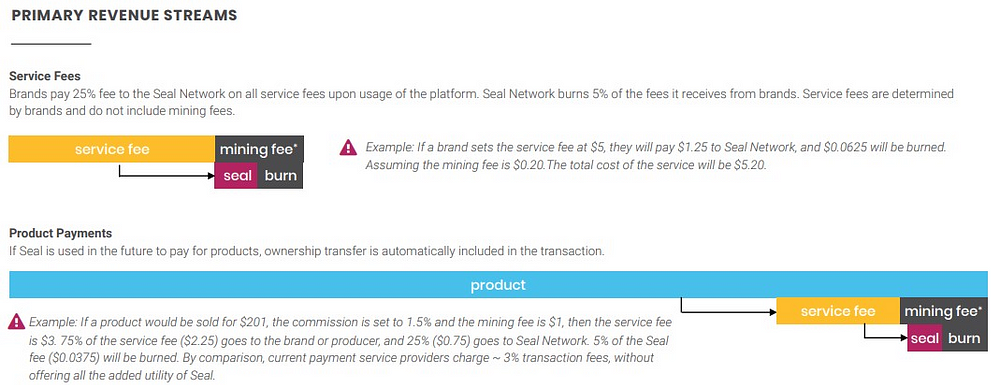
ICO Token Sale and Fund Distribution
Total ICO CAP of approx $33 million
The ICO presale has been confirmed for the 15th of April. The standard prices per token is 8 cents with various conservative bonus prices for early buyers.
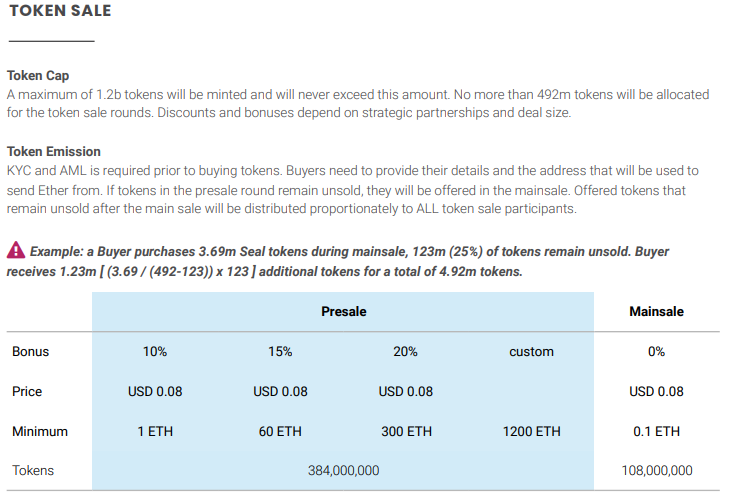

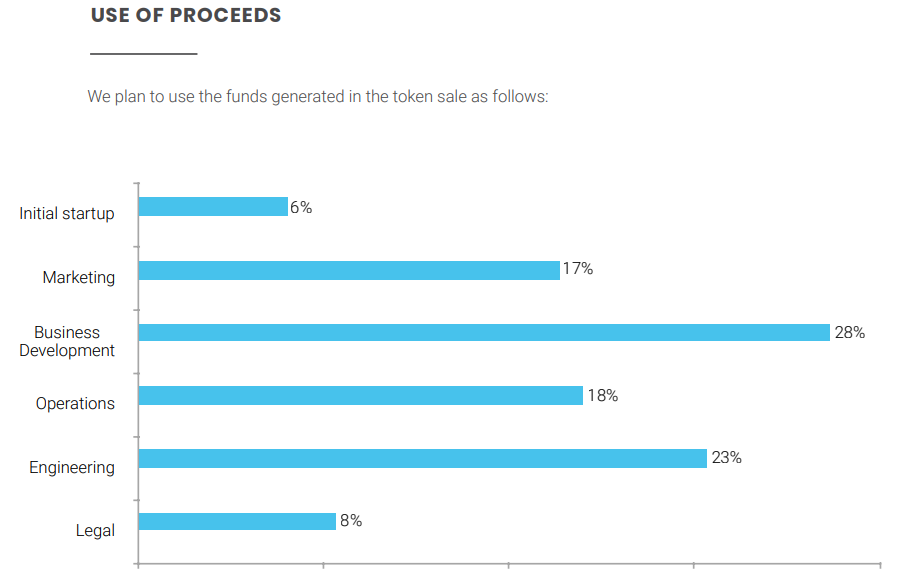
Seal already has a working product, two signed customers ready to go and more in the pipeline. The token metrics leave most of the tokens with seal with 22% for future operations and 17% for future R&D. This is usually a really a bit of a red flag but they are vested and will be unlocked for use in on boarding new brands and customers as well as developing an even more secure chip. New brands will grow the value of the tokens so they should cancel each other out and not have a negative effect on the tokens value once released.
Everything else seems pretty stock standard. In total it is around 41% for the ICO with some tokens for bounties and other influencers. You do need to note that there appears to be heavy private and whale interest from what I can see so there is a chance it may not even make it to the ICO stage.
Bounty Program
Seal have a bounty program that was just released so I am unsure of the details. Head over to the telegram channel to find out more details. They have also hinted at other incentive programs.
They also have a referral program. Details on their website. Both you and the person you refer can earn bonus tokens.
Road map
As far as road maps go they do have a lot of stuff coming up soon.
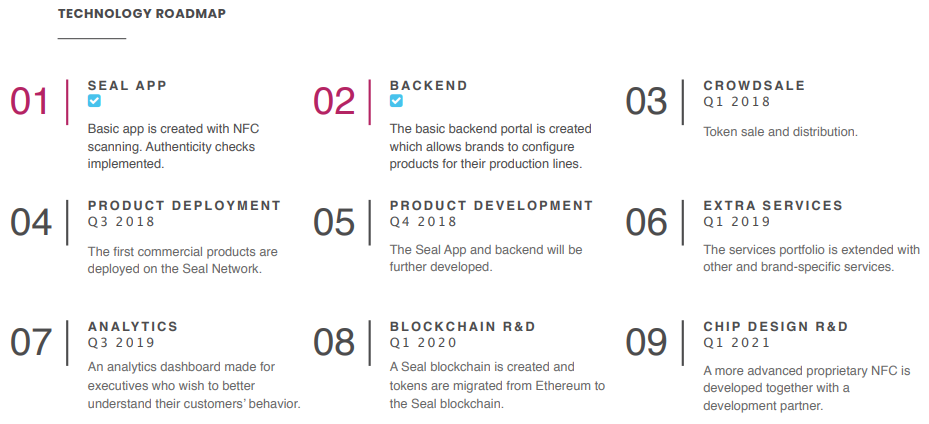
It is split into two which is nice, there is not much going on in Q2 other than brand acquisitions which is the most important part really.
Fore More Information:
- Website: https://seal.network
- Telegram: https://t.me/sealnetwork
- Twitter: https://twitter.com/seal_network
- Facebook: https://www.facebook.com/SEALnetworks
- White Paper: https://seal.network/seal-whitepaper.pdf
- Author:Agung pratama
- https://bitcointalk.org/index.php?action=profile;u=1807351https://bitcointalk.org/index.php?action=profile;u=1807351
Tidak ada komentar:
Posting Komentar